
Out of Thin Air (2)
- Dinosaurs, Birds, and Earth's ancient atmosphere -
Cat: SCI
Pub: 2006
#1812
Peter D. Ward
18810u
Original resume
Remarks
>Top 0. Introduction:
- The highest peak of the Himalayan mountains, Everest, 8,848m; pressures more akin to Mars's than of the Earth.
- Birds an not only exist at altitudes lethal to mammals but in this thin oxygen-poor air also perform the most extreme athletic exertion of flying.; have evolved a more efficient lung system than ours.
- If birds are so superior in thin air, what of their ancestors, the dinosaurs?
- On alien worlds we expect alien organisms.
- Many dinosaurs, cold-blooded yet active, were adapted for life in low-oxygen conditions through a superb new kind of respiratory system.
- A new insight about the eves of the most necessary and most poisonous of gasses, the giver and taker of life - oxygen.
- What exactly is an Earth-like planet?
- Our atmosphere is but a lice of a foreever-changing entity and is greatly different from the atmosphere at most times in Earth's history.
- Mammals: for most of our history were the size of rats, sluggishly grasping in a low-oxygen world as we avoided the active dinosaurian overlords.
- The history of atmospheric oxygen levels through time has been the most important factor in determining the nature of animal life - its morphology, physiology, evolutionary history, and diversity.
- Charles Wolcott, discoverer of the Burgess Shale that gives best look known as the Cambrian Explosion, more than 500ma.
- In early times the Cephalopoda ruled, later on the Crutacea, then Saurians and Sea Reptiles prevailed until Mammalia appeared.
- There are four important questions in the study of any history; what, when, how, and why?
1. 序文:
- cephalopoda: 頭足類
- crustacean: 甲殻類
- なぜ鳥類はヒマラヤ山脈上空の希薄な空気の中を飛行できるのか
- 酸素濃度の変化が、生命と繁栄と絶命の要因
- 地球型惑星とは
- 哺乳類の誕生時点
- カンブリア紀爆発以来の、支配動物の変遷
- 頭足類
- 甲殻類
- 恐竜と海の爬虫類
- 哺乳類
- 歴史研究の四大疑問:
- 何が, いつ, どのように,
そしてなぜか
>Top 1. Respiration and the body plans of animal life:
- Taxonomy: Family; Order; Class; Phylum; Kingdom
- Objective definition: ability of interbreeding
- actually, based on similarity of morphology
- About 600ma: a different environment
- more oceans, less land, higher temperature, more ultraviolet radiation, more carbon dioxide and less oxygen.
- no larger predators or herbivores; competition were only from their own kind.
- Respiration was the most important driver of animal body plans.
- Fossils and genetic records strongly suggest that the various phyla first originated as bottom-dwelling marine organisms.
- the need to move has affected the body design of many phyla.
- segmentation does allow a certain kind of movement such as in worms.
- with appendages attached, segmentation leads to other body plans.
- >Top Most underwater have little oxygen:
- body plan to live in low-oxygen environments would be very useful.
- presence of oxygen yields up to 10 times more energy than anaerobic respiration (like fermentation).
- old adage: it takes money to make money
- simple microbial life can derive its energy from a variety of sources, the choices decrease as life increases in size and complexity.
- >Top H-F bonds: yield the most energetic reactions per electron transfer.
- but fluorine has a huge disadvantage for life; it explodes when it comes into contact with organic molecules.
- the next best is oxygen; more than 200 enzymes are known that require oxygen as part of their synthesis.
- blood pigments cannot be completed in the absence of oxygen for chemical reasons of bonding.
- Cellular machinery: chemical reaction that changes ATP to ADP and a free phosphorus atom through a pathway involving water.
- there is no life on earth without ATP.
- organisms using this glucose plus oxygen chemical reaction to produce ATP from ADP by splitting O-H bonds. (aerobic respiration). chemical waster product - CO2.
- an animal that burns glucose by using oxygen makes more ATP per unit of time than does a bacterium using fermentation.
- >Top Hemoglobin: Fe-containing pigment
- exists in many phyla, including vertebrates, echinoderms, flatworms, mollusks, insects, crustaceans, annelids, nematodes, and ciliates.
- Hemocyanin: Cu-containing pigment found in gastropods, crustaceans, cephalopods, and chelicerates.
- Hemerythrin: Fe-containing pigment found in sipunculans, polychaetes, and priapulans.
- all these pigments bind O2 more strongly when O2 levels are high (in lungs or gills) and release it when O2 levels are low (in respiring tissues).
- O2 uptake is facilitated in the respiratory structures where levels are low (alkaline pH); and O2 release is facilitated in excess CO2 thus acid pH.
- Animal-free zone: Digging down into the sand:
- the black compounds as contrasted to an oxidizing one; reducing environment where O2 is in short supply.
- C, Fe, Pb have minerals that are dark in color; the lack of O2 that precludes animal life.
- Oceans are mixed:
- by composed of surface currents and deeper thermohaline circulation system, where cold, salt-rich, highly oxygenated bottom water is moved through the deeper oceans beneath warmer, fresher-water masses.
- much of Mesozoic; during warmer climates, there was much less of a heat gradient; widespread the dark anoxic ocean sediments.
- Concentrations of O2 and CO2:
- in water:
- O2: 7/1000 ML of water; affected by temperature and salinity.
- colder water holds more O2 than warm water.
- at equal temperatures, the well mixed body of fresh water will hold more O2.
- CO2 is far more soluble in water than O2.
- in air:
- O2: 209/1000 ML at room temperature at sea level. But with altitude, the amount of O2 drops off. at Mt. Everest is only 1/3.
- getting O2 from liquid, it must process 30 times more seawater; but high dissolution rate of CO2 in water comes to the aide of the water livers.
- both O2 and CO2 molecules are larger than H2O molecule, so that any membrane that allows these gases to diffuse will also leak water.
- in dryer environment, impermeable body coating is needed to halt desiccation, but there have to be places where gas can come in as well.
- Five factors control diffusion: 1) solubility of gas; 2) body temperature it maintains; 3) surface area available for gas exchange; 4) partial pressure of gases on either side of the respiratory structure; 5) thickness of the barrier itself.
- Organisms can increase the critical surface area to volume rations by changing their body plans from squat to elongated.; with numerous protrusions, fleshy spines, etc.
- locomotion requires great amounts of energy.; drowning victims die not from death of muscle, but from nerve cells.
- >Top Respiratory organs:
- gills (evaginations): used in water:
- pump gills; increasing the pressure differential on either side of the gill.
- use of countercurrent systems, such as fish.; blood flows forward against the current to oxygenated seawater crossing the gill.
- circulation system; to maximize the gas transport.
- lungs (invaginations): used in air.
- pump to lung chamber; by breathing to use muscles, diaphragm, to inflate lungs.; air is far less dense than water.
- Fe-bearing red blood cells, evolved specifically for O2 and CO2 transport.
- >Top Lystrosaurus: appeared in late Paleozoic, a time of rapidly falling oxygen.
- larger lungs would necessitate changes in the morphology of the blood vessels.
- the first evolution of endothermy; to allow warm air to go in and out of the body, to reduce water loss caused by breathing.
- Bird respiratory system: at least 33% more efficient than any mammal lung.
- the lungs of high-altitude such as Vicuna and Alpaca are among the best efficient mammals.
- O2 is the essential for animal life, and animal life consequently has evolved a host of structures for its acquisition.
- Respiratory organs are composed of mainly nonpreservable soft parts.
1. 動物生命の呼吸と体型:
- appendage: 付属肢
- anaerobic: 無酸素
- adage: 格言
- echinoderm: 棘皮動物
- flatworm: 扁形動物
- annelid: 環形動物
- nematoda: 線形動物
- ciliata: 繊毛虫類
- gastropod: 腹足類
- cephalopod: 頭足動物
- chelicerate: 鋏角類節足動物
- sipuncula: 星口動物
- polychaete: 多毛類
- priapulan: 鰓曳動物門
- eutrophic: rich in nutrient of a lake; ⇔dystrophic or oligotrophic
- disiccation: remove moisture
- protrusion: 突起物
- sluggish: 不活発な
- voracious: 大食の
- evagination: 外転, unsheathed
- invagination: 内転, turned inside or or folded back.
- diaphragm: 横隔膜
- 分類: K界, P門 (D門), C綱, O目, F科, G属, S種
- Hemoglobin:
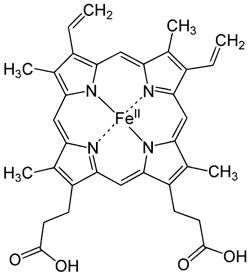
- Hemocyanin:
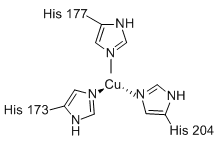
- Hemerythirin:
- Gill system:
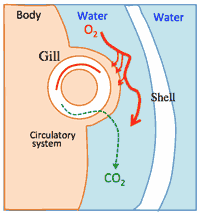
- Lung system:

- 呼吸システムの多様化
- 酸素濃度の変遷による変化
>Top 2. Oxygen through time:
- Today is quite atypical of Earth history:
- O2 were significantly lower less than 100 ma.;
- Atmosphere changes may be key to major evolutionary changes of life.
- even small changes in the temperature or chemistry of the global ocean can produce enormous changes in the atmosphere.
- today 21% O2, 78% N2; remaining 1% has a huge effect on the planet, CO2 and H2O as greenhouse gas.
- >Top The atmosphere is as old as Earth itself (4.6ba)
- enormous quantities of gas were trapped in the differentiating Earth and sequestered far beneath the surface.
- volcanic gas: 50-60% H2O, 24% CO2, 13% SO2, 6% N2; differs markedly from the current atmospheric composition.
- outer planets and moons from Jupiter outward are rich in water; brought by commets impacting in early history.
- Heavy Bombardment period: rain of comets onto the planet from 4.2 to 3.8 ba.
- CO2 partial pressure; 10,000 times higher than today.
- >Top banded formation of red beds: hematite sedimentation about 2.5 ba.
- U3O8 and FeS could not form in today's atmosphere.
- prior to 2.2ba there was no free O2 in the atmosphere and little O2 dissolved in seawater.
- >Top Where did all O2 come from?:
- photochemical reactions; broken by sunlight; a small percentage
- photosynthesis; by single-celled bacteria since 3.5ba.
- cyanobacteria widespread in the ocean (improperly known as blue-green algae).
- they use CO2 to produce free O2. (they cannot use it for energy)
- they also made N2 available to their protoplasm (Heterocysts)
- Endosymbiosis Theory: by Lynn Margulis.
- some members of cyanobacteria became the modern chloroplast; plant cells took place 2.7ba.
- build up of O2 in the atmosphere 2.3ba.;
- formation of ozone layer thick enough to shield life.; ozone cannot be used to burn sugars.
- the amount of O2 dissolved in seawater is affected by temperature; warm oceans might have little O2 (like modern Black Sea).
- Oxidation and reduction processes:
- Free O2 combines with molecules containing C, S, or Fe.
- O2 is liberated back by reduction of compounds; by C-cycle or S-cycle.
- S-cycle:
- Pyrite (FeS): S comes from S-rich sedimentary rocks, such as gypsum (CaSO4・2H2O) and anhydrite (CaSO4).
- huge quantities of pyrite locked in a variety of rocks, like dark shale.
- emission of volcanic gas: H2S, SO2; when this happens O2 levels can drop in the atmosphere during mountain building that exposes vast new reserves of S-bearing rocks to erosion.
- C-cycle:
- rate of burial of organic carbon, along with that of sulfuric compounds, is the major determinant of atmospheric O2 levels.
- there is no direct way to measure past O2 levels.
- A computer model (GEOCARBSURF):
- the rate of metamorphic and volcanic degassing of reduced C and S-containing gases.
- Geological time:
- animals first appeared about 540ma. (Phanerozoic)
- Cambrian-Ordovician: 15-16% O2 levels.
- there was a great increase in predation during the Mesozoic Era.
- shell-breaking or shell-boring adaptations; cased more shell defense in the prey organisms.
- Hypothesis 2.1: Reduced levels of O2 stimulate higher rates of disparity (diversity of body plans) than do high levels of O2.
- >Top Hypothesis 2.2: Diversity of animals is correlated with O2 levels. The highest diversities are present during times of high-O2 content.
- O2 levels less than 15% promote the formation of new taxa. (altitudinal compression)
- There would have been more endemisms (animals found in small geographic rea) during the low O2 times.
- low-O2 lung systems no longer needed in high-O2 conditions may have caused some competitive replacement and stimulated new evolution.
- >Top Mass extinctions and low O2:
- at least 15 over 500m years.
- The Big Five; all occurred in a time of very low O2 (<15%) as the case of Ordovician, Devonian, Permian and Triassic mass extinctions (ODPT) after 10% drop in O2.
2. 酸素濃度の歴史的変化:
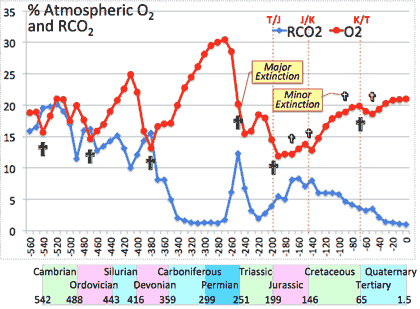
- <地質年代>
- Precambrian: 3958
- 300 Hadean: 4500-4100
- 1600 Archean: 4100-2500
- 1958 Proterozoic: 2500-542
- 古生代: 291
- 54 Cambrian: 542-488 ma
- 45 Ordovician: 488-443 ma
- 27 Silurain: 443-416 ma
- 57 Devonian: 416-359 ma
- 60 Carboniferouis: 359-299 ma
- 48 Permian: 299-251 ma
- 中生代: 186
- 52 Triassic: 251-199 ma
- 53 Jurassic: 199-146 ma
- 81 Cretaceous: 146-65 ma
- 新生代: 65
- 64 Tertiary: 65-1.5 ma
- Quarternary 1.5-0 ma
- hypoxia: 低酸素症
- accretion: 付着による増大
- sequester: 隔離される
- heterocyst: 異質細胞
- endosymbiosis: 内部共生
- phanerozoic: ⇔cryptozoic; since Cambrian period with abundant life
- Phanerozoic: 顕性代
- undergo: experience arduous
- endemism: <endemic; restricted to a certain place, 風土性の
- 火山ガス: 50>24>12>6%
>Top 3. Evolving respiratory systems as a cause of the Cambrian Explosion:
- What caused the rapid diversification of animal body plans in the Cambrian Explosion:
- the first complex fossils are older than 540ma;
- the first trilobites appeared in some single-digit millions of years after that.
- the Cambrian Explosion: for molecular geneticists, it marked the first evolution of animals large enough to leave remains in the rock record.
- life on Earth dis not predate 600ma; might be close to 550ma.
- the Cambrian Period 540-495ma; over those 50m years, the vast majority of animal phyla first appeared; the most important event in the entire history of life.
- O2 and CO2 in the Cambrian Period:
- O2 was about 13%, then fluctuated.; less O2 is dissolved in seawater with higher temperature.
- CO2 was tens of times higher, causing greenhouse effect; temperature was higher.
- A Cumbrian drive: circa 522ma:
- so little vegetation;most of the land surface is bare rock, like the area around glaciers.
- plant life is limited to moss and photosynthesizing bacteria; no trees no bushes, no flowers at all.
- a series of braided streams passing over the gravel of the land surface; no giant rivers
- air; amount of O2 like Mt. Everest but the seashore in terms of air pressure.; not thin air, it is low-O2 air.
- sand: composed entirely of minerals; no flake of seashell or bits of coral.
- tide change is at least 15m.; the moon is clearly closer to Earth.
- a variety of algae clinging to rock; reds and browns that wash in the rushing current.
- the Burgess Shale was deposited 510ma; were are in the world of 522ma, 13m years before the Burgess.; as Chéngjiān in China.
- numerous small sponges, most attached to cobbles on the bottom.; 30 kinds.
- priapulids; named Maotionashania
- bivalve brachiopods; extant Lingula.
- tiny tube-shelled hyoliths.
- familiar trilobites; fewer in number and diversity.
- a meter-long Anomalocaris.
- fish-like creature like eels, like hagfish; the first vertebrates; our ancestors.
- >Top Cambrian life: 542-488ma
- Chéngjiān; a new window into the origin of the animal phyla; 12M earlier than the Burgess Shale.
- huge abundance of creatures like soft worms and jellyfish; had no skeletons.
- the Burgess Shale: 150 species of animals; almost half are arthropods.
- Arthropods were the most successful of Cambrian animals.
- show repeated body units.
- exoskeleton cannot grow; must be periodically molted.
- the body has head, trunk, and posterior region.; appendages are specialized.
- two branches or parts per appendage; inner leg branch and outer gill branch. (biramous)
- exoskeleton was a design winner: a suit of armor; can be no passive diffusion of O2; had to evolve specialized respiratory structures or gills.
- >Top arthropods have more species today than any other phylum.
- all have limbs on each segment that are biramous; leg and long gill.
- annelids consist of largely separated chambers for each segment.
- segmented nature of the arthropod is related to the body movement or locomotion.
- to allow repeated gill segments; the flow of water across these pumping gills.
- O2 acquisition purposes primarily led to this body plan, only secondarily coopted for food acquisition.
- presence of segments in specific functions as locomotion, respiration, feeding, and reproduction through evolutionary processes.
- Trilobite (Fig.) turn out to have a very high gill to body volume ratio.
- Sponge: passes as much as 10000 items its volume in seawater through its body; functional pump gills; capable to live in extremely low-O2 conditions.
- >Top Brachiopod, second abundance:
- bivalve an brachiopod are radically different; lophophore creates several currents of seawater that pass into the sides of the shell.; first animal using a pump gill.
- Micromitra, a Burgess Shale brachiopod.
- >Top Mollusks; most diversed groups of animals.
- have a single unsegmented body, and none are jointed.
- dorsal body wall is cloaked by a large flap of tissue as the mantle.
- Cephalopods; a group of mollusks.
- shell evolved to increase efficiency of the respiratory rather than as a protective organ.
- protection from ultraviolet radiation or desiccation.
- earliest mollusks seemed to have designed with multiple sets of gills.
- succeeded in evolving a body plant that could move fast despite the scarcity of O2.
- muscular action, instead of cilia, created a high-pressure volume of water that passed over the gills.
- >Top Nautilus (Fig. of Ordovician):
- the iconic chambered shell function as a buoyancy organ.
- Pump gill respiratory system;
- each jet of water jerked the entire animal backward;
- the jet propulsion system still used by squids today.
- squid enters low-O2 can enter into the water masses, where fish cannot go; when O2 levels rose, they became even more efficient.
- Ammonite, descendants of the cephalopods, remained the dominant carnivores in the sea until 65ma of the Chicxulub strike.
- Chordates:
- >Top Pikaia (>Fig.); the origin of our own phylum.
- the phylum Urochordata, ancestor of the chordate, evolved in response to low O2 by producing efficient pump gill.
- water is sucked into the first tube, forced across a large gill, and then forcibly jetted out of the second tube.; the pump itself is powered by muscular action.
- the solution of the tunicate was one of the most elegant and effective; modified for use in a bilaterally symmetrical, swimming creature.
- End of Cambrian:
- a mass extinction, perhaps the first ever encountered by animals.
- the extinction appears to coincide with a rapid drop in O2.
- but the extinction was also an instigator of future diversity.
- the survivors were more efficient respires than those that died out.
- Ordovician rebound:
- O2 dropped at the end of the Cambrian was short lived.; there was a rebound in O2 levels; caused higher diversity of life.
3. カンブリア紀爆発に起因する呼吸機構の進化:
- biramous: dividing to form two branches
- exoskeleton: 外骨格; ⇔endoskeleton
- annelid: 環形動物
- carapace: 甲羅
- blunt: 尖っていない
- paddle: へら
- gnathobae: 顎基
- surmise: 推測する
- postulate: 仮定する
- epithelium, epidermis:上皮, 被膜細胞
- nemertean; ribbon worm
- cnidarian: aquatic invertebrate animal, 刺胞動物
- invagination: cavity or pouch so formed, 陥入
- choanocyte: 襟細胞
- echinoderm: 棘皮動物, ウニ・ヒトデ
- ambulacrum: 歩帯
- monoplacophora: 単板綱
- brachiopod: 腕足類
- bryozoan: コケムシ
- lophophore: 総担, shape of a horseshoe bearing ciliated tentacles
- dorsal: 背側の
- cephalopod: 頭足類
- desciccation: 乾燥
- gastropod: 腹足類, ナメクジ・カタツムリ
- ciliary: まつげ、毛様体
- buoyancy: 浮力
- pelagic: 遠洋の
- septum: 隔壁
- siphuncle: 連室細管
- osmotic: 浸透圧の
- chordate: 脊索動物
- urochordata: 尾索類
- tunicate: 被嚢類
- sessile: 無茎性の
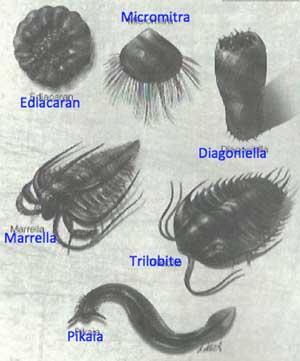
- カンブリア紀の特徴
- O2濃度: 13%
- CO2濃度: 現在の10倍
- 外骨格
- 二肢形
- 澄江?
- 節足動物
- Segmentation: =iteration?
- 腕足類:
- ホオズキガイ、シャミセンガイ (lamp shells)
- 軟体動物:
- 頭足類: タコ・イカ
- オウムガイ・アオイガイ
- Chicxulub Crater
- 65maに直径10-20kmの隕石が落下。白亜紀末の恐竜絶命の原因とされる。
- KT Extinction
>Top 4. The Ordovician: Cambrian explosion Part II:
- Land in Ordovician: 488-443ma
- more O2 in the Ordovician.
- it is greener by spread of mosses; no trees or even rooted plants.
- on the land surface not vertebrates, but diversity of scorpion and centipede-like arthropods.
- there is much more bare rock than outside the desert.
- size and shape of reef that we didn't see in the Cambrian.
- Sea in Ordovician:
- warm bottom looks the same because the most common bottom dwellers are sponges.
- numbers of bivalved creatures, brachiopod are more advanced than the small ones of the Cambrian.
- Both bryozoans and brachiopods show a large feathery device used for feeding - lophophore.
- stony reefs, made up of archeocryathids; colonial corals, tabulates, stromotoporoids.
- the reef community here is made up of an entirely different.
- no fish; no anomolocarids
- nautiloids have toppled the arthropods as the top carnivores.;
- discovered neural buoyancy.
- the best respiratory system.; relatively large gills compared to the size of the fish.
- >Top In brackish wateer; thre are fish in this fresh water called ostracoderms. (>Fig.); have small sucking mouths without jaws, with extensive dermal body armor in the form of massive scales and larger bony plates, having reversed heterocercal tail.
- O2 in Ordovician:
- now more O2 in Ordovician; still lower than today.
- The mass extinction occurred either simultaneous with or soon after a drop in O2 level.
- ever-better respiratory system to deal with ever-larger bodies.
- Cambrian: manly small animals less than an inch.
- Ordovician: much larger animal.; this bigness came about through changes in respiratory systems.
4. オルドビス紀: カンブリア紀爆発第二章:
- vascular: 維管束の
- braid: 三編みにする
- meander: 曲がりくねる
- brachiopod: 頭足類
- bryozoan: コケムシ
- lophophore: 総担フサカツギ, 触平冠
- ostracoderm: early jawless fossil fish
- dermal: 真皮の
- heterocercal: 不等尾の
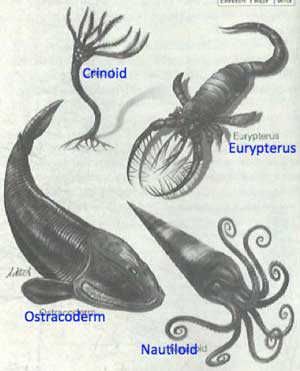
>Top 5. The Silurian-Devonian: How an oxygen spike allowed the first conquest of land:
- Silurian (443-416ma) and Devonian (416-359ma)
- great reefs grew
- fish began to vie with cephalopods for dominion in the oceans; brachiopods covered the warm sea bottom.
- the land was greening, and plants rose up from the soil.
- early land animals in breaking new ground.
- O2 rose 10% points, from 15% to 25%.
- high O2 of Silurian has allowed the rise of the first insects, the rise of plants on land, and the first age of giants in fresh waters.
- a small-sized diversity of insects (like springtail or silverfish)
- jawed fish heavily armored. (Placoderms)
- >Top Eurypterid (>Fig. in Ordovician): 3m long; the largest animal ever inhibit in the sea.
- amount of O2 available to an animal is a determinant of its final size.
- it was 24%: these giants are enabled by high O2.
- Cope's Rule: mostlineages of animals become larger through time; large size lends protection against predation.
- the end of Devonian, O2 levels will crash to far lower values than today.
- Mass extinction in 368ma.
- 430ma:
- Proto-scorpions with water gills crawled out of the water and moved about on land.
- common insects didn't appear until 330ma.
- 410ma: high-O2 peak, followed by a rapid fall.; then highest levels in Earth history in Permian (299-251ma)
- Had O2 levels not risen, animals might never have colonied land.
- Colonization of land by animals (arthropods and verterates) took place in two waves: one from 430-410ma, the other from 370ma onwards.
- Terrestrialization:
- The conquest of land; first by plants and then by a succession of animal phyla began in Silrian-Devonian.
- Evolutionry advances in arthropods, molusks, annelids, and vertebrates.
- O2 rose to levels allowing land animal life.
- Plant revolution:
- 600ma; green, brown, and red algas; CO2 and nutrients were eaily available in seawater.
- Charophyceae, gave rise to photosynthetic land plants.; havi resistant cuticle against desiccation.
- small holes called stomata evolved for gaseous CO2.
- problem of support; one solution is to simply lie fat (like mosses)
- competition between low-growing plants; evolved stems and finally tree trucks.
- formation of vast new amounts of organic cargon on land for the first time, animals were quick to follow.
- Problem is to allow reduction in surface desiccation; then suffocate?
- Animal revolution:
- 430ma proto-scorpions with water gills crawled out of the water and moved on land; but stile tied to waer for reproduction.
- 420-410ma; small spiders, scorpions, primitive insects have very wakly clacified exoskeletons.
- in a very high O2 atomosphere, air can diffuse across the body wall of very small land animals.
- arthoropods were to succeed for their skeletal box in providing protection from dessiccation.; problem was respiration.
- terrestrial arthropods, spiders and scorpions, produced new respiratory structure called a book lung; which was a passive lung and there is no curret of air inhales.
- flying insects appeared some 330ma.
- 410ma; high-O2 peak
- Evolution of terrestrial vertebrates:
- first amphibian; first colonized the land.
- Rhipidistian: bony fish in fresh water, ancestors of the first amphibians.
- crossopterygian and lung fish:
- ealiest tetrapods: could they breathe in air withouft help of water-breathing gills.
- about 450ma: split of amphibian from their ray-finned ancestors.
- 400-360ma: transtion from fish to amphibians; characterizes rapid drop in O2.
- the time of low or lowering O2 stimulated the most consequntial evolutionary changes - formation of new body plans.
- >Top Ichthyostega: primitive tetrapod from Greenland came soon after the late Devonian mass extinction.
- anatomy of Ichthyostega: have been very inefficent on land; prety mush a fish with legs.
- Romer's Gap (360-340ma): evolutonary radiation of amphibians did not take place until about 360-340ma, taking at least 20m years.
- none of Devonian tetrapods had any sort of tadpole stage; they went directly from egg to land dweller.
- Perdepes: the first true amphibian between 354-344ma.
- supporting a heavy body in air required extensive changes to shoulder girdle, pervic region, and the soft tissues that integrated them.
- Transiton from gill to lung: gill is still an evagination; there had to be a complet inversion of this system, for a lung is a series of sacs, wheras a gill is a series of protuberances.
- >Top Devonian mass extinction (370-368ma): one of the five most servere mass extinctions.
- Very low O2 level about 12-14%.
- causes from an asteroid impact to climate change.
- Colonization of the land came in two steps:
- the first invation (410-400ma): a time of high O2
- second invation (330-300ma): after the Devonian mass extinction through Romer's Gap.
- Romer's Gap ended (340ma) in Carboniferous Period (split in two in America; Mississippian and Pennsylvanian Periods.)
- O2 levels nearly 35%, crating a unique interval in Earth history.
5. シルル紀〜デボン紀: 酸素濃度急上昇
- annelid: 環形動物
- stoma, stomata: 気孔
- chordate: 脊索動物
- sprintail: トビムシ
- silverfish: 西洋シミ
- placoderm: 板皮綱
- eurypterid: 広翼類
- accolade: 称賛
- ichthyostega: イクチオステガ, デボン紀後期の最古の両生類
- anoxia: deficiency of O2
- tadpole: オタマジャクシ
- evagination: 外転, turned inside out
- protuberance: 突出部
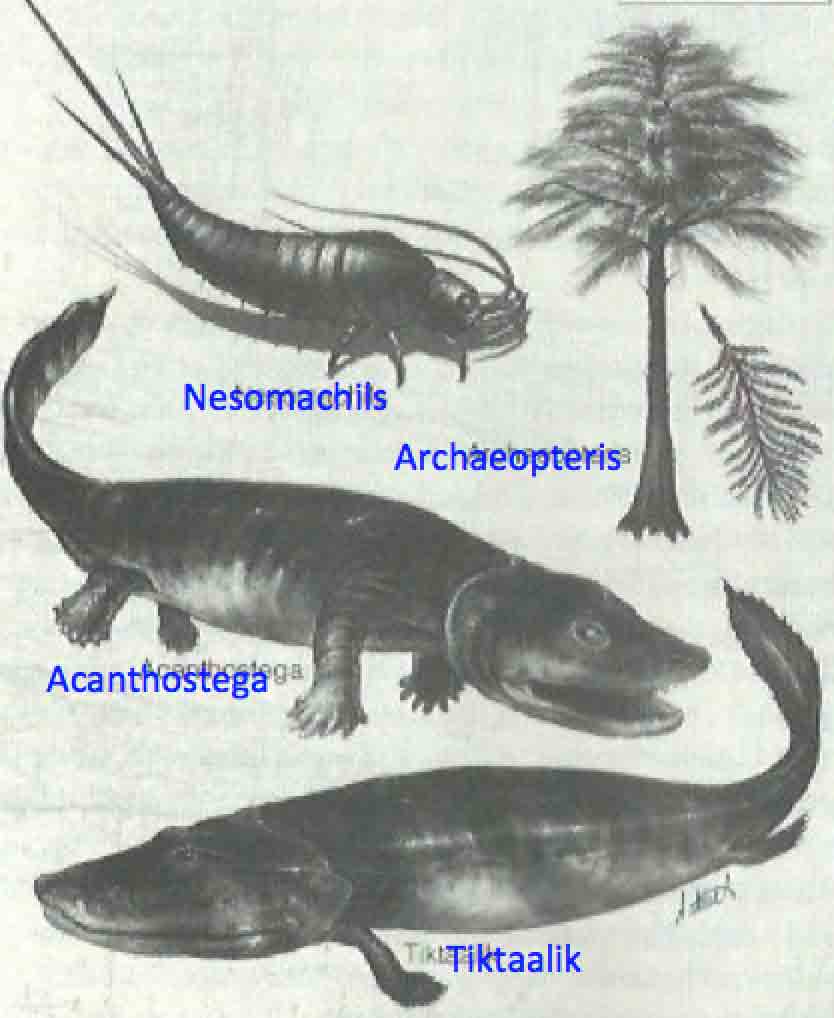
- 各紀でのO2濃度の変動:
- Cambrian: 16-21%
- Ordovician: 15-20%
- Silurian: 17-25%
- Devonian: 13-23%
- Carboniferous: 17-26%
- Permian: 20-30%
- Triassic: 14-18%
- Jurassic: 12-14%
- Cretaceous: 13-20%
- Tertiary: 18-21%
>Top 6. The Carboniferous-Early Permian; High oxygen, fires, and giants:
- The largest size:
- most animals grow as large as they can; but there are costs to this.
- What limits this growth:
- biomechanics of animal design:
- the strength of chitin making up the arthropod exoskeleton, a giant ant or preying mantis of even human size would collapse.
- limit of respiration: size limited by the degree to which O2 can diffuse into the innermost of bodies. (no insect is bigger than about 15cm); arthropods in water can be bigger.
- Voyage to 300ma:
- O2 was highest 30% in Earth's history.
- Color of the sky; is polluted yellow-brown, due to smoke from giant fires perpetually ranging.
- Air is cold; this time of most extensive glaciations in Earth's history.
- forest: unending vista of conifer-like trees; gymnosperms (pines and fir trees) evolved and have swept away earlier dominant plants.
- the land is alive with animals and arthropods:
- dragonflies; nearly 1m-wide wings.; spiders, scorpions, and millipedes and may are also giants.
- In swamps, giant amphibians, some 3m long, lie like modern-day crocodiles.
- Land vertebrates, freed from water by the evolution of amniotic eggs, are similar large;
- Dimetrodon (>Fig.), the Sail Back; and smaller reptiles, turtles, lizards, crocodiles, and dinosaurs.
- In oceans:
- a huge diversity of fish; the largest are cartilaginous sharks
- chambered cephalopods.
- all nautiloids are gone replaced by ammonoids - cephalopods with shells that look like that of the living chambered nautilus, but soft parts more akin to modern squids.
- all nautiloids are gone, replace by ammonoids - cephalopods with shells; look like living chamber nautilus.
- crinoid or sea lilies; looks like endless fields of flowers; their stony stalks make up the majority of bottom sediment.
- Reef habitat:
- Sponges have take the place of corals.
- large brachiopods; one with spines, the other like a large garbage can.
- >Top Insects:
- O2 extraordinarily high: 320-260ma
- Dragonfly (discovered in 1979); Meganeura (>Fig.) with wingspan some 50cm; even larger 76cm; today's dragonfly is less than 6cm.
- mayfly 48cm wingspan; spider 45cm; millipede 90cm; and scorpion 90cm, weigh 22kg, formidable predator of all land animals including amphibians.
- It is the insect respiratory system that dictates maximum size; air diffuses into the tissues from these fine tubes called trachea.
- insect's rhythmic expansion and contraction of the abdominal region, or flapping of its wings to create air currents around the tracheal opening.
- flying insects achieve the highest metabolic rates of any animal.
- in insects, higher O2 very quickly promotes larger size.
- O2 partial pressures rose but not at the expense of other gases; the total gas pressure was higher than today.
- O2 levels are mainly affected by burial rates of reduced carbon and sulfur-bearing minerals.
- 90% of coal deposits are found in 330-260ma; the rate of coal burial was 600 times higher.
- Carboniferous Period was the time of forest burial on a spectacular scale.
- too large amounts of organic-rich sediments accumulated on sea bottoms.
- the continents of the time coalesced into one singe large continent. (Pangaea)
- In Carboniferous many of the bacteria that decompose wood were not yet present. Trees would fall and not decompose. Eventually sediment would cover the unrotted trees and reduced carbon would be buried in the process.
- plants evolved as fire resistance traits; thicker bark, deeply imbedded vascular tissue, and sheath s of fibrous roots.
- roots can be smothered by ground water with low-O2.
- Sluggish evolution:
- Low O2 stimulated new kinds of evolution but were also time of low diversity.
- During high O2 times, conversely, diversity is high but the rate of new specie formation is low.
- Cooling climate (or glaciation) was the a cause of this slow interval of evolution.
- Cooling is a killer and cause of mass extinction.
- Reptiles:
- The evolution of amniotic egg differentiates reptiles, birds, and mammals from amphibians.
- Reptiles were monophyletic stock that diverged from amphibian ancestors more than 320ma.
- Land eggs: moisture must be conserved; but reducing permeability of the egg to water moving from inside to outside also reduced the movement of O2 into the egg by diffusion.
- eggs are either covered with a calcareous shell or a softer more leathery shell.
- today, all birds utilized calcareous eggs, while all living reptiles that lay eggs use leathery covering.
- embryos developed by the live birth method are not endangered by temperature change, desiccation, or O2 deprivation. But the cost is added to the mother.
- egg layers are not burdened with this problem but have the trade-off of a less safe environment.
- >Top body plan of early land tetrapods; a sprawling posture with legs splayed out to the sides; in walking, the trunk is twisted first to one side and then to the other; each breath must be taken between steps.
- this process makes it impossible to take a breath when running.
- modern amphibians and most reptiles cannot run and breathes at the same time.
- this is why reptiles and amphibians are ambush predators; they do not run down their prey.
- the best of modern reptiles, Komodo dragon, will sprint for no more than 10m. (Carrier's Constraint)
- early amphibians an reptiles evolved a three-chambered heart.
- Endothermy, Ectothermy, and Third category:
- endothermy: warm-bloodedness
- ectothermy: cold-bloodedness; big boy size unaffected by daily swings in temperature.
- all mammals and birds are warm-blooded, having hair or feathers.
- all living reptiles are cold-blooded, with no hair or feathers.; the status of extinct forms remains controversial.
- Dimetrodon (>Fig.): synapsid reptile;
- the sail device; rapidly heat the animal in the morning hours; both predators and prey could warm their large bodies quickly, allowing rapid movement.
- Reptiles and their size:
- there is a strong correlation between terrestrial animal size and O2 level.
- drop in size of Triassic forms compare to their Permian ancestors.
6. 石炭紀・初期ペルム紀: 高濃度酸素・山火事・巨大化:
- echinoderm: 棘皮動物
- gymnosperm: 裸子植物 ⇔angiosperm
- lepidodendron: 鱗木
- millipede: ヤスデ
- dimetrodon: 竜盤目ディメトロドン、背中に帆あり
- crinoid: ウミユリ
- amniotic fluid: 羊水
- veritable: 紛れもなく
- trachea: windpipe, 気管
- monophyletic; 単一系統, ⇔polyphyletic
- endothermy: 内温性動物 Cf: homoniotherm
- ectothermy: 外温性動物
- anapsid: 無弓類
- synapsid: 爬虫綱単弓亜綱
- diapsid: 爬虫綱双弓亜綱
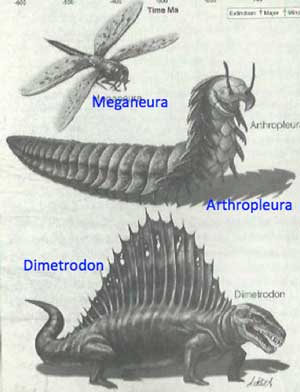
>Top 7. The Permian extinction and the evolution of endothermy:
- the Permian Extinction (251ma); 90% of all speceis.
- Prominent victis in the sea:
- all trilobites, all reef-building cnidarians,
- majority of brachiopods, most crinoids, most brhyozoans, many mollusks, majority of ammonoids, many fish stocks.
- On land extiction:
- great reductions of all stocks of plants and animals.
- A voyage to 251ma: cause of the extinction: one of the most vexing and still unsolved geological mystery.
- 270-200ma: Change of atmosphere
- rapid rise of CO2 and rapid drop of O2 density(35% in early Permian to 12% in early Triassic)
- O2 is even lower than 500ma.
- carbon-rich material was buried much less than early Permian.
- pyrite sediment also dopped dramatically.
- ultimate cause:
- Supercontinent Pangea was completed; many sedimantary basins and swamps were uplifted.
- CO2 dropped 300M ago drastically reduced amount of plants.
- a large-body impact with Earth 251ma.
- CO2 catastrophe
- Methane catastrohe
- low O2 caused by Siberian traps
- H2S poisoning
- Fauna: there is no ice at the poles.; the world is hot and desert-like.
- Littel plant life; soil erosion has caused great dune fields.
- lack of diversity is the most striking aspect.
- last predatory gorgonopsian (>Fig.)
- even insect are rare here.
- Ocean color: not blue, but a deep purple, with untold numbers of purple and green bacteria, reflecting toxic H2S.
- oceans and lakes release H2S.
- Metablolism and evolution of endothermy:
- Endothermy is the characteristc of birds and mammals;
- metabolism is the work of every cell necessary to stay alive
- each cell needs energy to stay in disequilibrium with the environment.
- accomplished nearly optimal chemical conditions for growh, reproduction, energy acquisiton and other aspecs of life.
- turinals in nasal area:
- might have evolved because of low O2 content.
- to reduce respiratory water loss.
- global temperature rose at the same time with O2 dropping.
- animals would have had to breath more frequently, causing greater drying.
- predation requires more activity than herbivory.
- Four-chambered heart:
- two auricles (atria) and two ventricles.
- many repties and all amphibians have 3-chambered heart.
- 3-chambered heart, mixing can take place; reducing oxygen-carrying capacity.
- 4-chambered heart evolved for allowing elevated blood pressure rathe than blood itself.
- respiratory adaptations in late Permian - early Triassic therapsids:
- the size of nasal passages and size of secondary palate area showed significant increase.
- end of Permian: O2 level at sea level is equvalent today at 4500m.
- even modest set of hills would have isolated but the most low O2 tolerant animals.; areas higher than 900m are uninhabitable.
- many separate biotic provinces.
- altitude became the new barrier to migration.
- flora:
- Permian shows two trends - a change in the kind of flora during the period and a substatial extinction of plants at the end.
- Crossroads:
- Triassic wa truly crosroa of animals adapted to two different worlds of higer O2 and lower O2.
7. ペルム紀絶滅と内温化動物の進化:
- turbinal: 鼻の甲介骨
- therapsid: 獣弓目
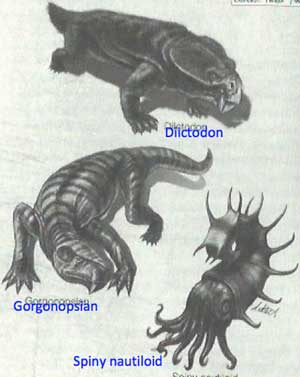
>Top 8. The Triassic explosion:
- Triassic explosion:
- new stocks of bivalved mollusks
- a great diversification of ammonoids and nautiloids refilled the oceans with active predators.
- on land; most sweeping changes in body plan replacements.
- Triassic was a huge experiment in animal design; opened the way fro more innovation than any other nonextinction time.
- body plans were being stimulated into creation by intense selective pressures.
- "Nothing sharpening the mind faster than imminent death."
- 'An evolutionary bomb'; exploded in Triassic.
- the Cambrian Explosion followed a mass extinction of the Ediacaran fauna (lower O2 than today).
- in this end-Triassic mass extinction the dinosaurs suffer least of all. Why dinosaurs?
- Voyage:
- 215ma:
- cynodonts: dog-like creature; carnivorous varieties but massing herbivores too.
- carnivores mostly lay in wait, and herbivores browse stolidly (panting rapid).
- O2 levels at sea level is equivalent to 3,000m in our world.
- most of carnivore dinosaurs; smaller bipedal forms.
- but soon much larger form, 4m in length.
- staurikosaur, the top carnivore, it is very active.
- ammonites; evolved from the few ammonites survived the Permian extinction
- 250-245ma:
- O2 level 10-15%:
- there was little recovery from the Permian extinction.
- methane gas entering the oceans.
- But difficult times are what best drive the engines of evolution and innovation.
- on land new groups were to emerge: mammals and dinosaurs; the former would become bridesmaids, the latter would take over the world.
- >Top bipedalism:
- by removing the quadruped stance; freed of the constrains of motion and lung function.
- mammals also made new innovations; secondary palate (allows simultaneous eating and breathing) and complete upright (but still quadruped) stance, with powerful set of muscles.
- Dinosaur:
- 235ma: dinosaurs first appeared in 2/3 of Triassic Period; like smaller versions of later Tyrannosaurus rex.
- bipedal forms; evolved as a reponse to the lowest level of O2 since Cambrian Period.
- bipeded; breathing can be disassociated from locomotion.
- modern mammals; show a distinct rhythm by synchronizing breathtaking with limb movement.
- horses, jackrabbits, and cheetahs take one breath per stride.
- with running slight up-and-down browing is coordinated with air inspiration and exhalation.
- by running on two legs, the lungs and rib cage are not affected; bipeds can take as many breaths as they need.
- >Top Bipedal Pterosaurs:
- Bipedal Pterosaurs; simplified into a simple hinge joint from more complex ystem found in quadrupeds.
- quadrupeds; moved slowly on all fors but reared up on its hind legs fro bursts of speed.
- lengthening of the hind limb relative to the forelimbs.
- neck elongates and forms a slight S shape.
- one took to the air or fast runner (began gliding between long teps): pterosaurs.
- evolved five-fingered hand; two were so vestigial that only three toes touched the ground.
- bipedal, elongated neck, grasping hands with a functioning thumb, a large and distinctive plvis for the masive muscles
- >Top division of dinosaurs into two divisions: saurischians and ornithischians
- Amniote lungs:
- derived from a single kind of Carboniferous reptilian ancestor which had simple sac-like lungs.
- alveolar lungs: consist of millions of highly vascularized sacs called alveoli; air flows in and out of the sacs; by rib expansion and diaphrgm contraction.
- when a bird inspires air, it goes first into air sac, then passes into the lung tissue proper; the air pases one direction, and blood in the blood vessels in the lungs passes in the opposite direction.
- some of the air sacs, such as the abdominal air sacs in modern bbirds, leave no record of hard parts.
- the situation of dinosaurs; oen proposed tht dinosaurs had air sacs, theor had simpler reptilian lung system.
- Air sacs in dinosaurs?
- birds evolved fro small bipedal dinosaurs called saurischians.
- the first bird skeltons are from the Jurassic.
- birds were warm-blooded.
- pneumatic bones: dinosaur bones had curious hollows.
- birds bones were light to enhance flying, and the air sacs attached to bird lungs restd in hollows in bones.
- Archaeopteryx: evolved in middle of Jurassic.
- Saurischan dinosaurs most probably had the avian air sac system.
- Triassic-Middle Jurassic dinosaurs:
- Triassic was a time of low O2; climae was was much hotter than today; no icecaps, no glaciers even in the moutains.
- Phylogenetically, dinosaurs are postioned between crocodiles and birds.
- Crocodiles are cold-blooded with hepatic piston lungs.
- Birds with warm blood and air sac system.
- first bipedal dinosaurs - all predators; endothermy use 5-15 times of O2 than ectotherms.
- large-sized animals could remain homoeothermic.
- earliest dinosaurs were like lions, sleeping 20 hours a day to conserve energy, but when hunting doing so acrively.
- >Top Back to the sea:
- Low O2 and high CO2 (=hot) world; they need more oxygen thatn in a cool world to run faster metabolic reactions.
- it is to return to the sea.;Triassic ichthyosaur Cymbospondylus (>Fig.)
- inverse correlation between Mesozoic O2 level and the number of marine reptiles. (>Fig.)
- when O2 was low, the percentage of marine reptiles was high. But as O2 rose, the proportion of tetrapod families that were fully aquatic markely dropped.
- From low-oxygen air:
- Dinasaur diversity was strongly dependent on atmospheric O2 levels. (>Fig.)
- though the late Triassic and first half of Jurassic, dinosaur numbers were both stable and low.
- O2 rose in the Jurrassic, hitting 15% or more in the latter part of the period. It was then the nuber of dinosaurs began to increase; also the sized of dinasaurs increased. (the latest Jurassic tryough the Cretaceous.)
- Triassic-Jurassic Mass Extinction:
- 200ma; Trassic-Jurrasic boundary; O2 was 13% at sea level.
- Every group except Saurischian dinosaurs was under going reduction (or at bet, mainining) (>Fig.)
- The groups with the simplest lungs (amphibians and thecodont reptiles) fared the worst.
- Saurischian was unique in possessing a highly septate lung with air sacs; kept dominace will into the Jurassic.
- Low O2+ high CO2 + H2S poisoning was the major cause of T/J mass extinction.
8. 三畳紀爆発:
- cynodont: 犬歯類
- diapsid:爬虫類双弓亜綱
- pterosaur: 翼竜目
- ornithoid: 鳥に似た
- vetigial: 退化した
- pubic bone: 恥骨
- saurischian: 竜盤目
- ornithischian: 鳥盤目
- amniote: 羊膜動物; 爬虫類・鳥類・哺乳類
- alveolar: 肺胞の
- diaphragm: 横隔膜
- archaeopteryx; 始祖鳥
- ichthyosaur: 魚竜目, 海生爬虫類
- septate: 隔膜のある
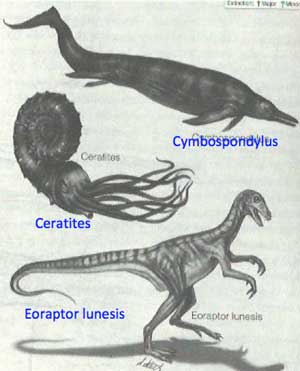
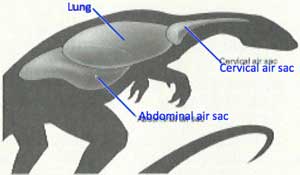
- Inverse correlation between
Mesozoic
O2 levels and
the number of marine reptiles:
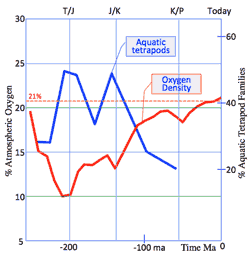
- Mesozoic higher O2 supported a hgher diversity of dinosaurs.
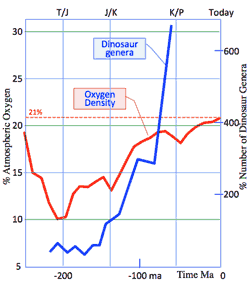
- Triassic-Jurassic mass extinction
(only Saurischian dinosaurs 竜盤目grows)
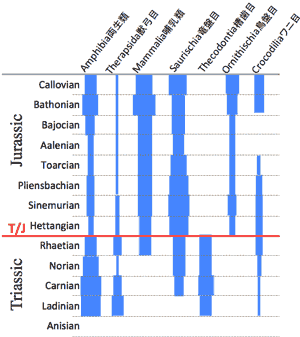
>Top 9. The Jurassic: Dinosaur hegemony in a low-oxygen world:
- On land the dinosaurs flourished
- Mammals retreated in size and numbers to become a minor aspect.
- Birds evolved from dinosaurs in the latter Jurassic.
- Jurassic -Cretaceous Period were times of innovations on land, in sea, and in air.
- Three distinct kinds of flyers were in the skies: pterodactyls, pterosaurs, and birds, with the last evolving from saurischian bipeds during latter Jurassic.
- Six stages of dinosaur faunal makeup:
- Dinosaur body shapes: fully upright
- bipeds:
- short-necked quadrupeds
- long-necked quadrupeds; typically long-tailed saurischians
- History of dinosaurs:
- Middle Triassic:
- the earliest dinosaurs appeared in the last third of Triassic, but remained 15M years.
- majority of forms were bipedal, carnivorous saurischians.
- then quadrupedal saurischians evolved.
- ornithischians diverged from saurischians before the end Triassic.
- dinosaur size was small 1-3m long.
- Late Triassic:
- first substantial radiation of dinosaurs occurs.
- first gigantism, such as Plateosaurus of Upper Triassic.
- Early to Middle Jurassic:
- continuation trend of late Triassic; saurischian bipeds and quadrupeds dominated.
- ornithischians remaining small, diversified into major stocks, including heavily armored thyreophorans, including the first stegosaurs.
- split into two groups in late Triassic: prosauropods and true sauropods.
- prosauropods went extinct in middle Jurassic.
- sauropods radiated vastly into late Jurassic.
- bipedal saurischians showed diversity in lower & middle Jurassic.
- >Top saurischians split into two groups; ceratosaurs and tetanurans.
- ceratosaurs dominated early Jurassic.
- split into two groups; ceratosauroids and coelophysids
- coelophysids eventual produced the most famous dinosaur; late Cretaceous Tyrannosaurus rex, although mi Jurassic were considerably smaller.
- tetanurans increased in number by middle Jurassic.
- >Top Upper Jurassic:
- this was the time of the giants.; typically Allosaurus.
- armored ornithischians also increased in size, like heavily armored stegosaurs, ankylosaurs, nodosaurs, camtosaurs, ad hypsilophontids.
- Early to Middle Cretaceous:
- large sauropods dominated.
- ornithischians increased in diversity until outnumbered saurischians.
- knew flowering plants appeared.
- Upper Cretaceous:
- Dinosaur diversity skyrocketed.
- large numbers of new ornithischians; ceratopsians, hadrosaurs, and ankylosaurs.
- only a small number of sauropods were present.
- angiosperms made up 90% of vegetation by the end Cretaceous
- herbivory is dependent on the correct kind of teeth for the available plants.
- Jurassic-Triassic dinosaur lungs:
- metabolism and respiration:
- upright position: developed respiratory efficiency
- lost endothermy, replacing it with passive ectothermy to reduce O2 consumption.
- attained larger size.
- air sac system
- >Top Evolution of birds:
- birds had endothermy and different kind of lung
- the first bird appeared about 150ma (Archaeopteryx), just before Cretaceous.
- O2 had been rising for 50M years.
- ancestors of the first bird; bipedal carnivorous saurischians known as troodontids or dromaeosaurids; which were already feathered?
- diversity of birds since early part of Cretaceous.
- use a great deal of energy to fly; small size and endothermy, great users of O2.
- air sac system serves.
- Eggs:
- all birds lay eggs with a porous calcareous shell; no live births in birds.
- extant reptiles have many lineages using live birth.
- eggshell consists of two layers; inner organic membrane, and CaCO3 layer or leathery and flexible membrane (no crystalline material).
- flexible parchment eggs (some turtles and some lizards)
- soft parchment eggs (most snakes and lizards)
- fossilization: numerous hard eggs (many from dinosaurs), a few flexible eggs, and no soft eggs.
- >Top plenty dinosaur eggs from (mainly late) Cretaceous, far fewer from Jurassic, none from Triassic. (but the absence of evidence is not necessarily evidence of absence.)
- this would certainly be the case if pre-Cretaceous eggs were leathery like those of extant reptiles.
- or like marine ichthyosaurs, like birth rather than egg laying.
- dinosaur eggs were usually ornamented with either longitudinal ridges or nodular ornamentation.
- advantage of calcareous eggs; strong, harder fro predators to break into.
- some CaCO3 is dissolved in bone growth.
- calcareous eggs have pores so that O2 can enter but not so many that water quickly leaves.; egg has a large amount of albumin, which provide water to the embryo.
- parchment egg can take up water, or lose water easily too.
- burying an egg presents some danger; if egg is buried too deeply, the embryo will suffocate.
- O2 levels certainly pay a part as well. Lizards living at altitude often show live birth.
- evolution of live birth may have come about in response to lowering O2 in the late Permian.
- O2 can diffuse through the wall of a modern parchment egg more readily than in a calcareous egg.
- Calcareous egg in late Jurassic as a response to rising O2.
- reproductive strategy that was not viable in late Permian through middle Jurassic of lower O2.
- Reptiles show four different kinds of reproduction: 1) live births, 2) parchment eggs that are held within the mother for extended periods, 3) parchment eggs that are laid soon after formation within the mother, and 4) calcareous eggs.
- Jurassic-Cretaceous in the seas:
- dangerous places to swim in; fish and cephalopod eater plesiosaurs; mosasaurs and ichthyosaurs as the top carnivores.; aquatic body plans related to O2 levels in the seas:
- low-O2 tolerant bivalves:
- methanogens thrive in lor or no O2 conditons; they release methane as a byproduct.
- clams use these chemicals as food.
- low-O2 cephalopod:
- coccoliths and foraminifera: by-product is the formation of more CO2.
- death and ultimate burial of these two planktonic groups have geological effect.
- coccolithophorids evolved in Triassic but began to appear during Cretaceous and after; they were so abundant to produce rock type, chalk.
9. ジュラ紀: 低酸素世界での恐竜の覇権:
- pterodactyl: 翼手竜
- pterosaurs: 翼竜
- prosauropod: 古竜脚類
- sauropod: 竜脚類(竜盤目竜脚亜目)
- ceratopsian: 角竜亜目
- tetanuran: 獣脚類
- ankylosaur: 曲竜類(鳥盤目曲竜亜目の草食恐竜)
- plesiosaur: 首長竜
- mosasaurs: 海成オオトカゲ
- ichthyosaur: 魚竜
- foraminifera: 有孔虫綱
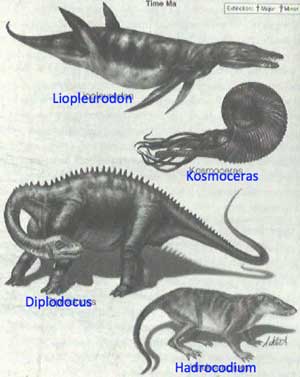
>Top 10. The Cretaceous Extinction and the rise of large mammals:
- A large asteroid smashed the Cretaceous world in fire and toxicity.
- even weeks after the impact, the damage had been done.
- dinosaurs were all dead, as were all ammonites, rudistid clams, mosasaur.
- disappearance of dinosaurs allowed mammals to fill the emptied world. (mammalization)
- History of Cenozoic mammals:
- ancestors of mammals were dominant until the Permian extinction.
- cynodont of late Triassic were same or larger than early dinosaurs.
- first placental mammals occurred; 100-60ma (estimated by molecular clock)
- all Mesozoic mammals were small.
- mammals didn't compete with dinosaurs for ecological reasons.
- in the hot, low-O2 world, larger, a warm-blooded, highly active mammal needed to eat much more than a cold-blooded form.
- body size:
- the first size increase occurred in the first few M years after K/T extinction; to fill now-emptied ecological niches.
- the second increase in size happed in Eocene Epoch (57-35ma) due to rise of O2.
- Fetal blood picks up its O2 from admixture (arterial and venous); the fetus is exposed to O2 levels that are lower than the mother's arterial blood.
- Mammals can survive up to 8,500m, but no mammal reproduced above 4,200m which corresponds to the O2 levels of early Jurassic.
- Placental system of reproduction was not possible until O2 levels above 15% or approaching 20%.
- O2 levels 28% 5ma.
- Nervous system tissue needs more O2 than any other tissue; rapid enlargement of brain volume.
- the fate of O2 rate is fixed by that organic compounds and sulfur containing compounds and pyrite are buries.
- Mammals did not compete with dinosaurs:
- in the hot and low O2 world (at least of late Triassic until end of middle Jurassic) a larger, warm-blooded, highly active mammal was just too energetically expensive to exist.
- an animal that needed to eat much more than a cold-blooded form.
- dinosaurs were a really different kind of beat than anything, until Cretaceous, were the only kind of animal that worked really well in the peculiar early and mid-Mesozoic conditions.
10. 白亜紀絶滅と大型哺乳類の興隆:
- rudistid: 超科の二枚貝
- mosasaurs: 海成オオトカゲ
- therapsid: 獣弓目(哺乳類の祖先)
- cynodont: キノドン類, 犬歯類
- placental: 胎盤
- insectivore: 食虫類
- rodent: 齧歯類
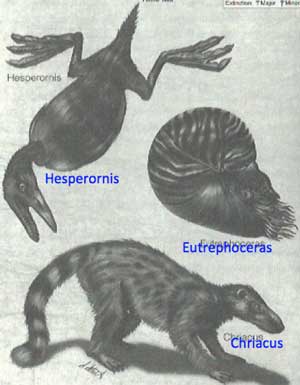
- 哺乳類:
- 大型, 恒温性, 活発な哺乳類は、後期三畳紀〜中期ジュラ紀まではエネルギー的に非コスト的
- 恐竜:
- 白亜紀までは、当時の環境に最適化していた唯一の動物。但し、環境変化(O2濃度など)の好条件を活かしきれなかった。奢れる恐竜久しからず。
>Top 11. Should we fear the oxygen future?
- 21-22C will continue global warming from CO2 produced by humanity.
- from not the Earth will have returned to tis atmospheric condition during late Cretaceous through Eocene.
- Earth awaits at least seemingly endless cycles of ice and warming for another 2.5M or 5M, or even 10M years.
- Earth is heading for greater warmth caused by increased energy of the sun and by a new global geography (eroding high mountains)
- Continental drift:
- Cambrian Explosion; the continents were widely dispersed along the equator.
- next 200M years, larger land bodies and major mountain chains (Appalachians)
- about 300ma a single united block, a super-continent Pangea
- about 200ma, huge expanse of land began; creating Atlantic Ocean
- 120ma: southern continents broke apart, with Africa, Antarctica, India, and Australia moving in divergent directions.
- for next 250M years, there will again be a supercontinent, like end of Paleozoic Era some 250ma.
- both ice cover of Greenland and Antarctica melt, the oceans will rise nearly about 90m.
- changing span of O2 level: from Carboniferous over 30%, then began to drop minimal value of 10% some 210ma.
- now microbes quickly attack felled trees, ante the process of decomposition uses O2.
- about 100M from now, the continent will have reached maximum separation.
- by 250M years into the future, continue amalgamation will have been completed, forming a supercontinent.
- when the supercontinent break apart, it may be that Earth will once again experience a major drop in O2, the equivalent of the Permian mass extinction.
- O2 is to be loved and hated - but also respected. Will it be an epitaph for our planet?
11. 我々は酸素濃度の未来予想を危惧すべきか:
- epitaph: 碑文
- 地球の未来
- 大陸移動
- カンブリア爆発
- 次の200M年後
- 300ma: 超大陸パンゲア
- 200ma: 大西洋生成
- 120ma: 南の大陸分裂
- 次の250M後: 再び超大陸;
古生代末の状況
Permian大量絶滅
- Greelandと南極が氷解すると
- O2レベルの変化期間: 30%→10%へ
- 細菌による倒木の分解
- 100M年後, 大陸の分裂
- O2ほど愛され嫌われたものはない。これは地球の碑文となるか
>Top 12. Respiratory systems among various animal groups: (各種動物による呼吸方式)
Taxon
Medium
Type
Absorption surface
Blood flow
Source of pump
Cham.
Pigment
Humans
Air
Pump lung
Complex alveoli
High
Diaphragm
4
Hemoglobin
Birds
Air
Pump lung with air sac
Simple alveoli in lung, and internal surface of air sacs
High
Ribcage, pelvic
4
Hemoglobin
Lizards
Air
Pump lung
Simple alveoli
Low
Diaphragm
3
Hemoglobin
Crocodiles
Air
Pump lung
Simple alveoli
Low
Pelvic pump
3
Hemoglobin
Saurischian dinosaurs
Air
Pump lung
?
?
Ribcage, pelvic
4
?
Fish
Water
Counter current gills
Gill surface
Low
Rib ventilation
2
Bivalve mollusks
Water
Medium pressure
Pump gills
Low
Cilia in siphon
1
None
Chambered cephalopods
Water
Complex gills, high pressure pump gills
High
Adductor muscle contraction
1
Hemocyanin
Brachiopods
Water
Low pressure pump gills
Lophophore surface, punctae
Low
Cilia
0
None
Scleractinian corals
Water
No gill epithelial adsorption
Epithelium, internal mesentaries
None
None
0
None
Echinoids
Water
External gill, adsorption tube feet
Gill surface
Low
Water vascular system
Bryozoans
Water
Lophophore
Epithelial absorption
Low
Cilia
0
None
Sponges
Water
No gills, medium pressure pump
Choanocyte cell surface
None
Cilia
Flagellar beating
None
Tunicates
Water
Internal gill, medium pressure pump
Internal gill surface
Low
Cilia
Comment
- The key factors affected evolution of creatures are density of O2 and CO2.
- We could overview the long historical evolution on the Earth using such elegant and simple parameters.
- In case of researching extraterrestrial lives, we need first to measure such densities.
- This also suggests important parameters for a nation to survive; offense, defense, as well as economics enabling effective respiration.
- 生物の進化に最も影響を与えたのは酸素と二酸化炭素の濃度である。
- 長い地球上の長い進化の歴史を単純明快なパラメーターによって外観できる。
- 地球外生命を探査する場合でも、まずこれらの濃度を測定する必要がある。
- また国家が生存する場合の重要なパラメーターの示唆を与える。即ち、攻撃・防御と効率的な呼吸ができる経済である。
Out of Thin Air (2)- Dinosaurs, Birds, and Earth's ancient atmosphere - |
Cat: SCI |
|
Peter D. Ward |
18810u |
Original resume |
Remarks |
|
>Top 0. Introduction:
|
1. 序文:
|
>Top 1. Respiration and the body plans of animal life:
|
1. 動物生命の呼吸と体型:
|
>Top 2. Oxygen through time:
|
2. 酸素濃度の歴史的変化:
|
>Top 3. Evolving respiratory systems as a cause of the Cambrian Explosion:
|
3. カンブリア紀爆発に起因する呼吸機構の進化:
|
>Top 4. The Ordovician: Cambrian explosion Part II:
|
4. オルドビス紀: カンブリア紀爆発第二章:
|
>Top 5. The Silurian-Devonian: How an oxygen spike allowed the first conquest of land:
|
5. シルル紀〜デボン紀: 酸素濃度急上昇
|
>Top 6. The Carboniferous-Early Permian; High oxygen, fires, and giants:
|
6. 石炭紀・初期ペルム紀: 高濃度酸素・山火事・巨大化:
|
>Top 7. The Permian extinction and the evolution of endothermy:
|
7. ペルム紀絶滅と内温化動物の進化:
|
>Top 8. The Triassic explosion:
|
8. 三畳紀爆発:
|
>Top 9. The Jurassic: Dinosaur hegemony in a low-oxygen world:
|
9. ジュラ紀: 低酸素世界での恐竜の覇権:
|
>Top 10. The Cretaceous Extinction and the rise of large mammals:
|
10. 白亜紀絶滅と大型哺乳類の興隆:
|
>Top 11. Should we fear the oxygen future?
|
11. 我々は酸素濃度の未来予想を危惧すべきか:
|
>Top 12. Respiratory systems among various animal groups: (各種動物による呼吸方式)
|
Comment |
|
|